Sua página de login do WordPress continua sendo atualizada e redirecionada quando você tenta fazer login no seu site?
Esse problema o bloqueia na área de administração do WordPress, impossibilitando-o de trabalhar em seu site.
Neste artigo, mostraremos como corrigir o problema de atualização e redirecionamento da página de login do WordPress.
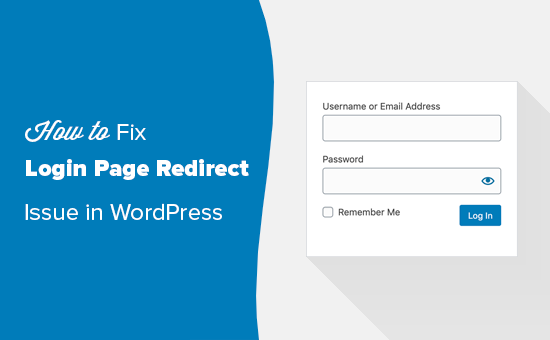
O que causa o problema de atualização e redirecionamento da página de login no WordPress?
O erro de atualização e redirecionamento da página de login do WordPress geralmente é causado por configurações incorretas de URL do WordPress ou falha na definição de cookies de login.
Normalmente, quando você faz login, o WordPress valida seu nome de usuário e senha e, em seguida, define um cookie de login no seu navegador. Depois disso, ele o redireciona para o painel do WordPress.
Se o WordPress não conseguir definir o cookie de login corretamente ou se o URL da área de administração do WordPress estiver incorreto, você será redirecionado para a tela de login em vez do painel de administração.
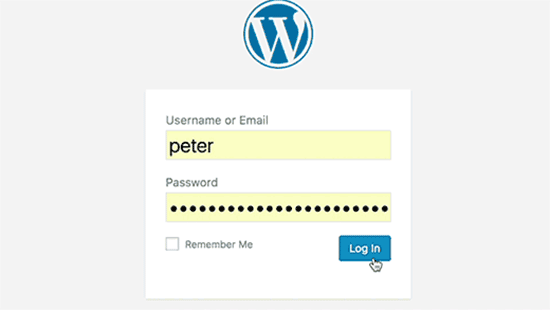
Os problemas de login também podem ser causados por diferentes erros do WordPress, como o erro ao estabelecer conexão com o banco de dados, erro interno do servidor ou a tela branca da morte.
Com isso em mente, vamos solucionar e corrigir o problema de redirecionamento e atualização da página de login do WordPress. Você pode usar esses links rápidos para ir para um método específico:
Observação: se você quiser experimentar as etapas avançadas deste tutorial do WordPress, crie primeiro um backup do seu site. Consulte nosso guia sobre como criar manualmente um backup do banco de dados do WordPress.
Tutorial em vídeo
Se você não gostar do vídeo ou preferir a versão escrita, continue lendo.
Método 1: Limpar cookies para resolver problemas de login
O WordPress usa cookies para autenticação de login, portanto, a primeira etapa na solução de problemas de login do WordPress é a mais simples. Você precisará limpar os cookies e o cache do navegador.
No Google Chrome, basta clicar no menu de configurações do navegador e selecionar Mais ferramentas ” Limpar dados de navegação.
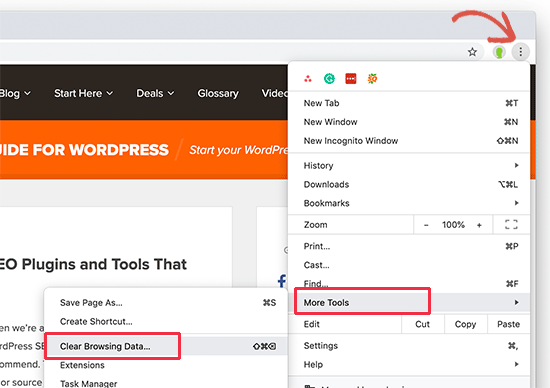
Isso abrirá a página Configurações do Chrome com um pop-up “Limpar dados de navegação” exibido na tela.
A partir daí, você precisa selecionar as opções “Limpar cookies e outros dados do site” e “Imagens e arquivos armazenados em cache”.
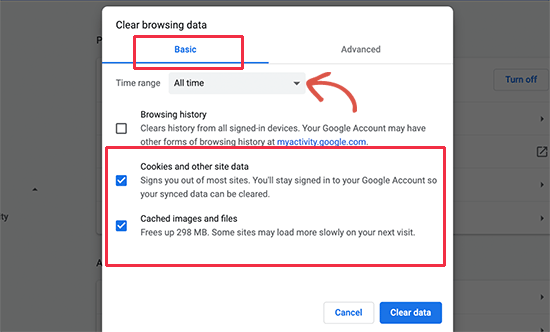
Em seguida, clique no botão “Limpar dados”, e o Google Chrome limpará o cache do navegador.
Além disso, certifique-se de que seu navegador tenha os cookies ativados. Depois de fazer isso, reinicie o navegador e tente fazer login. Isso deve corrigir o problema para a maioria das pessoas.
Temos um guia completo com capturas de tela que mostram como limpar o cache e os cookies em todos os principais navegadores.
Método 2: Atualizar as configurações de URL do WordPress
O WordPress vem com configurações para a URL de seu site e a URL de sua instalação do WordPress.
Se você tiver acesso à área de administração do WordPress, poderá ver essa opção na página Configurações ” Geral.
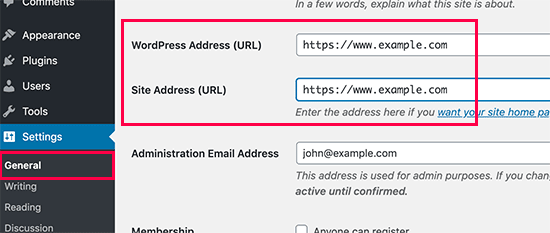
Se esses URLs estiverem incorretos, o WordPress o redirecionará de volta para a página de login.
Como não é possível acessar a área de administração do WordPress, você precisará editar o arquivo wp-config.php para corrigir esse problema.
O arquivo wp-config.php é um arquivo especial no WordPress que contém suas configurações importantes do WordPress. Você pode acessá-lo usando um cliente FTP ou por meio do aplicativo File Manager no painel da sua conta de hospedagem do WordPress.
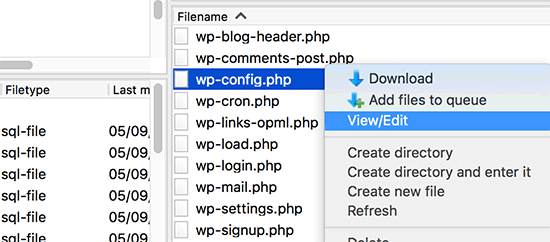
Você encontrará o arquivo wp-config.php na pasta raiz do seu site. Basta editar o arquivo e colar as seguintes linhas de código logo antes da linha que diz: "Isso é tudo, pare de editar! Feliz publicação".
define('WP_HOME','https://www.example.com');
define('WP_SITEURL','https://www.example.com');
Não se esqueça de substituir “example.com” por seu próprio nome de domínio.
Depois disso, salve as alterações e carregue o arquivo de volta em seu site.
Agora você pode visitar o site do WordPress e tentar fazer login. Esperamos que isso tenha resolvido o problema para você. Caso contrário, continue lendo para ver outras etapas de solução de problemas.
Método 3: Excluir o arquivo .htaccess no WordPress
Às vezes, o arquivo .htaccess pode ser corrompido, o que pode resultar em erros internos do servidor ou no erro de atualização da página de login.
Basta acessar seu site usando um cliente FTP ou por meio do aplicativo File Manager no painel do seu provedor de hospedagem.
Uma vez conectado, localize o arquivo .htaccess no diretório raiz do seu site e faça o download para o seu computador como um backup.
Se você não conseguir encontrar o arquivo .htaccess, este guia sobre por que o arquivo .htaccess pode estar ausente poderá ajudá-lo.
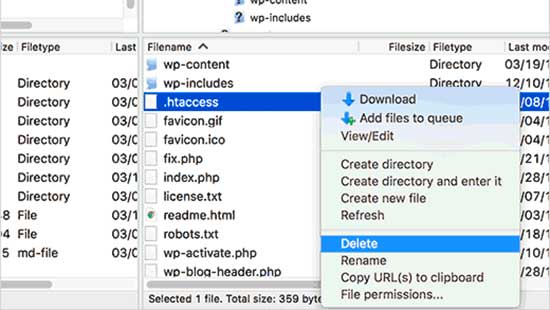
Depois disso, vá em frente e exclua o arquivo .htaccess de seu site.
Em seguida, abra o diretório wp-admin e, se houver um arquivo .htaccess lá, vá em frente e exclua-o também.
Agora você pode tentar fazer login no site do WordPress. Se conseguir, isso significa que o arquivo .htaccess estava impedindo que você fizesse login no WordPress.
Depois de fazer o login, basta acessar a página Configurações ” Permalinks no painel de administração do WordPress e clicar no botão “Salvar” sem fazer nenhuma alteração. Isso gerará um novo arquivo .htaccess para seu site.
Método 4: Desativar todos os plug-ins do WordPress
Às vezes, os plug-ins do WordPress podem causar esse problema, especialmente se houver um conflito entre dois plug-ins.
Para desativar facilmente todos os seus plug-ins do WordPress, conecte-se ao seu site usando um cliente FTP ou por meio do aplicativo Gerenciador de arquivos no painel da sua conta de hospedagem na Web.
Depois de conectado, vá para o diretório /wp-content/. Dentro dele, você verá uma pasta chamada “plugins”. É nessa pasta que o WordPress instala todos os seus plug-ins.
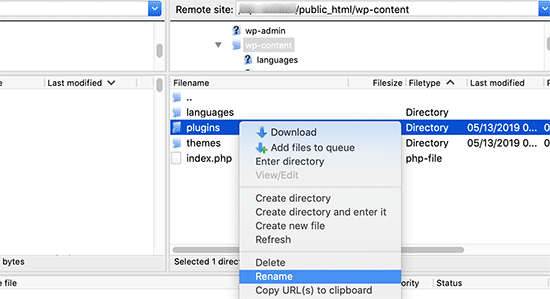
Basta renomear a pasta de plug-ins para “plugins_backup”. Isso desativará todos os plug-ins do WordPress instalados em seu site.
Também temos um tutorial detalhado sobre como desativar todos os plug-ins do WordPress quando o administrador do WordPress estiver inacessível.
Depois de desativar todos os plug-ins, tente fazer login no site do WordPress. Se tiver êxito, isso significa que um dos plug-ins estava causando o problema.
Método 5: Reverter para o tema padrão
Os temas do WordPress também podem causar conflitos após a atualização para uma versão mais recente do WordPress ou do próprio tema. Para descobrir se o problema está sendo causado pelo seu tema, será necessário desativá-lo.
O processo é semelhante ao da desativação de plug-ins. Conecte-se ao seu site usando um cliente FTP. Em seguida, vá para o diretório /wp-content/themes/ e renomeie o diretório do tema atual para “themes_backup”.
Depois de fazer isso, tente fazer login novamente. Se tiver sucesso, isso significa que seu tema estava causando o problema.
Agora você pode reinstalar uma nova cópia do tema para ver se isso resolve o problema. Se o problema reaparecer, será necessário entrar em contato com o suporte do seu tema ou mudar para um tema diferente do WordPress.
Esperamos que este artigo tenha ajudado você a resolver o problema de atualização e redirecionamento da página de login do WordPress. Talvez você também queira ver nosso guia completo de solução de problemas do WordPress ou conferir nossas principais opções dos melhores plug-ins e ferramentas do WordPress para expandir seu site.
Se você gostou deste artigo, inscreva-se em nosso canal do YouTube para receber tutoriais em vídeo sobre o WordPress. Você também pode nos encontrar no Twitter e no Facebook.





Syed Balkhi says
Hey WPBeginner readers,
Did you know you can win exciting prizes by commenting on WPBeginner?
Every month, our top blog commenters will win HUGE rewards, including premium WordPress plugin licenses and cash prizes.
You can get more details about the contest from here.
Start sharing your thoughts below to stand a chance to win!
Eric says
I had to rename /wp-content/object-cache.php. Hope that helps for anyone who the other steps don’t work for.
Alisha says
When i type myurl.com/wp-admin the page shows blank. I can’t see any login panel either nor does my website opens… what is the cause?
WPBeginner Support says
Please see How to fix the WordPress white screen of death.
Administrador
Akeem says
editing the wp-config worked like a charm. thank you so much!
Jeff says
If you are having this issue, and nothing suggested here will work – log into the Cpanel and go into PHP My Admin, run a repair on your database table.
Micah says
Adding the code to the wp-config.php solved this for me.
define(‘WP_HOME’,’http://example.com’);
define(‘WP_SITEURL’,’http://example.com’);
Thanks for the article! It took me 3 hours sifting through other posts before I found your post and the resolution that I needed!
Micah
MuhdNurHidayat says
Thank you very much! You saved my day!!
Gordon says
This problem can also occur if your server hosting WordPress has run out of disk space. Freeing up disk space can solve it.
Victor says
You saved my day. I lost hours trying to find what the hell was wrong… thanks dude
Angelo says
Deleting the .htaccess worked for me. Thank you
Friday0 says
Sir please help me look at what am getting it started this night.
Fatal error: Call to undefined function
wp_is_mobile() in /home/u318928021/
public_html/wp-login.php on line 39
I don’t know what to do
WPBeginner Support says
Seems like a plugin or your WordPress theme is causing this error. Deactivate all your WordPress plugins and check if this resolves your issue. If it does then you need to reactivate plugins one by one. This will help you find the plugin causing the error. If deactivating all plugins does not resolve the issue, then switch to a default WordPress theme like Twenty Fifteen. If switching theme resolves the issue, then the problem is your with your WordPress theme.
Administrador
Luis says
Thanks, it was a plugin conflict. I just deleted some useless crap via ftp and now it’s all sorted.
Thomas Le Coz says
You guys saved my ass. I was stuck outside a client site after messing with a SSL certificate and some stuff on managed account.
Never encountered this issue before, got saved by your guide.
Thanks
Eva Duli says
Nothing of these work for me. I want to work the site localhost but when I am trying to login in the admin it redirects to the old admin login. Do you have any idea?
Marco Panichi says
My problem was that I hadn’t renew the database and the provider denied my user to insert/update the database.
The error I received was: “INSERT command denied to user ‘Sqlxxxxxx’@’xx.xxx.xxx.xxx’ for…”
So the solution in my case was:
1) activate the debug into wp-config.php > define(‘WP_DEBUG’, true); in order to discover the problem
2) renew the database
Hope this help!
JohnnZenith says
I have a wordpress.com blog and all these instructions either are not relevant or I do not understand them, so I guess i’m going to leave it.
WPBeginner Support says
These instructions are for self hosted WordPress.org sites. Please see our guide on the difference between WordPress.com and WordPress.org
Administrador
chris says
I cant find my .htaccess file? I can find it in my rootfirectory but not on my subdomain (where I have a whole new wordpress site). What do I do? It is my first time ever to log in to my subdomain wordpress.
Kenny says
The dreaded Internal Server Error and web host support quickly identified a corrupted .htaccess. Spent next 3 hours trying to find how to use my ImportBuddy when I didn’t have WP Admin access. Finally thought to check WPBeginner, found the .htaccess issue above and 30 seconds later had fixed the issue. Next time I come here first!
Thanks guys and gals.
Drew says
Changing the wp-config.php file did it for me! This is the second time I’ve had this issue in two weeks, so I think the fix via htaccess was only a temporary solution.
joel says
Seriously a life saver! Corrupted .htaccess files was my issue. But following your steps helped me solve it. Much, much appreciated!
Sumdi says
Its working
Have rename .htaccess and update WP_HOME, WP_SITEURL to proper URL in wp-config.php file….
rubenjm says
I had this issue, tried all these options and none worked for me.
Finnally solved it… apparently my database was overloaded!! I had to login through phpmyadmin and delete and clean some tables. Hope it helps someone!
Moises says
Which tables clean you?
Liviu says
I did all of the proposed solutions, but nothing works for me! It keeps refreshing and redirecting it back to the login screen. Changing the folder of my current theme gives the white screen of death. It doesn’t revert to the default theme. Any other idea, please?
Being at a dead end, I’m thinking to download all the site through ftp, make a new one site from WordPress and then upload one by one all my content. I’m worry however if I’ll be able to insert all the customization settings afterwards. The current theme was made custom by another person which cannot help anymore. Is it safe to do that? Thanks!
Mary Anne says
Thank you so much. I have WordPress pages built via my account with bluehost. One of my wordpress sites stopped working. I had the white screen of death.
I followed each step in order, until I found the step that worked to resolve my problem. The step that worked for me was, Revert Back To Default Theme. Instead of using an ftp though, because I was having a hard time with my fetch working, I logged into my bluehost account and went into my file manager and then accessed my wpcontent/themes/directory that way for changing the title of my current theme.
this worked perfectly. I was able to log back in and choose a different theme. Thank you again
Mary
Manish says
Hello,
Its not working for me. I had made every change into my site as per this tutorial still no luck. Added these two line in web config file.
define(‘WP_HOME’,’http://www.siteurl.com’);
define(‘WP_SITEURL’,’http://www.siteurl.com’);
deleted .htaccess file. but still same problem. My site running on 1&1 hosting.
Please help me.
Thanks
Manish
Umair says
Dear manish , there is small change use it will definitely work
1define(‘WP_HOME’,’http://example.com/wp-admin’);
2define(‘WP_SITEURL’,’http://example.com’);
Abdul Ghani says
Updating the site URL worked for me!
the wicked noodle says
Clearing my cache and cookies fixed it right away. Thanks so much!
Claudia says
Update Site URL worked perfect for me! Thank you!
WPBeginner Staff says
Contact your web hosting service provider. If they are unable to help then switch to a better WordPress hosting solution.
Louis says
Noting work for me… wp 3.9.1, Hostpapa hosting.
WPBeginner Staff says
Try checking your server error logs. You can also try increasing php memory limit. Let us know if this helps.
Beck Abad Lastimosa says
I have had my site for more than 6 months now and I finally decided to transfer hosting. After the transfer was successfully done, I as still able to access my login page. But these past few days has been a nightmare! I am was able to login to WP under the new DNS but as of this time, this problem suddenly occured:
– Everytime I login to WP admin, I should see the login page right? But what I get is a download of wp-login.php. I have tried checking issues ith the guide of WP Codex. I tried contacting GoDaddy (my new host) but they told me they do not handle coding, etc. Right now, I’m on a dead end! I have tried different browsers but I still get a download of wp-login.php instead of the login page showing itself.
I ould really appreciate it if you can help me.
Thilip kumar says
I Check with all the above but unable to login, I can ablre to see the login window, after I submitting login form. I Displays ‘.’ (Dot symbol)
Alison Withers says
You’re a godsend!!! Editing the config file to define the site address again did the trick.
Jaka says
YES! This did it for me too. Magic! Thanks!
Isak says
Did all of the above, nothing works. My main wp-login.php redirects me to one of my subdomains.
This is how the redirect problem occured:
1. My web hotel shut down my site, saying that it had been infected with malware.
2. I changed all my passwords via PhpMyAdmin as well as to the database.
3. I manually updated WP in my root directory as well as 2 out of 3 subdomains (the 3rd one already had the latest version) by uploading the new files and replacing the old ones, since I was not allowed to access my WP admin area.
4. I manually added a .htpasswd and .htaccess to my root WP install and tried to access wp-login.php. I tried my 3rd subdomain (the one with the latest install of WP) first and it worked. After that, I tried my main domain and came to a page saying “update database”, so I did. After that I tried again, but every time I try to reach my root install or any of the other subdomains, I get redirected to my 3rd subdomain.
Any ideas?
WPBeginner Support says
Open the wp-config.php file on the root site. Add these two lines to your wp-config.php file:
define('WP_HOME','http://example.com'); define('WP_SITEURL','http://example.com');1-click Use in WordPress
Replace example.com with your own domain. Also delete .htaccess file from all your subdomains and root domain. Once you get access to WordPress admin area on your root domain you need to go to Settings -> Permalinks and just save your permalink structure.
Administrador
Jesse says
Deleting .htaccess file from root directory worked for me. Thank you!!!
Moaz says
none worked for me!
Diane says
The extra lines in the wp-config worked! I love you! Thanks
carl says
WP-config worked for me too! I could kiss you!
Jonny says
WP_SITEURL did it for me. Seems illogical but it worked, so thanks for the tip! This only started happening recently to me – I wonder if it’s more prevalent with subdirectory installs with newer versions of WP.
igor says
ok I deleted all plugins and it works but whenever I add any plugin it does the same thing
Anna says
Thank You
It was really helpful, great info … Resolved y issue by adding site name in wp-config.
Regards,
Peter Evans says
Recently WP started getting me to login ever 5 of so minutes. I noticed that my wp-config.php did not have the following lines
define(‘WP_HOME’,’http://example.com’);
define(‘WP_SITEURL’,’http://example.com’);
and when i inserted then the need to login was a less but I was then told that my session has expired and I needed to relogin in.
This is very frustrating and I would be greatful if you could assist me. I am using WP 3.6.1
Peter Evans
Aamna says
and Yes if your wp-config.php file does not provide you a solution.
Try going to functions.php of your theme via ftp and add same two lines right below the <?php line and upload again. here you go !!!
it works for me
Aamna says
Thanx a lot the site URL was the solution … Thank you Thank you Thank you
W.J.Kok says
I use Epic Browser for testing because that browser will not store cookies (by default). Therefore clearing the caches will not delete all my stored passwords in the process.
W.J.Kok says
Set chmod wp-admin at 750 did kill my admin login access. So, now I use 755.
Brent Norris says
Had a special case of the redirects all day. This particular post, out of about 20 keyed me in on a solution. Just wanted to say, “thanks!” Your perspective was a refresh after ten hours chasing down a solution.
It was the part about generating a new .htaccess file that made the difference for me. Wish I could be more helpful to others but the problem I was having wasn’t very related and wouldn’t make a lot of sense to your readers.
Aloha
Editorial Staff says
So glad that we were able to help you Brent
-Syed
Administrador
Adrian says
Thanks a lot for the ‘Update Site URL’ fix. That solved an issue I was battling with for a while and saves me from any further headaches.
Omar says
This was really frustrating me but thanks to your tip on updating the URL my site is now working. Thanks!
Haseeb Ahmad Ayazi says
This error is very rear with WordPress but mostly occir in Blogger
Paul says
I normally get this error when working with multisite, normally it’s a cookie path problem which can be fixed by changing the wp-config.php.
Robert Connor says
I really needed this tutorial it happens to me all the time usually a plug in conflict. I am addicted to plugins. Thanks staff! Have a great day on purpose…
Kartik eye says
I had the same issue, few days ago. I was trying to enable the wpmultisite function for my new website with sub directories. My website is hosted on bluehost. I did everything step by step. But after editing all the files like wpconfig.php and htaccess. When I finally tried to login, I was getting a redirect to the same wp login page. I disabled the multiste and then everything was fine again. Please can you help with this?
lelebon says
I tried everything — I said every little advice here — to no avail. Until I noticed I was using wp_config.php instead of wp-config.php. That simple! It solved my problem. HURRAY!!
Anyways, thanks for the tips. Hope I can help someone too.